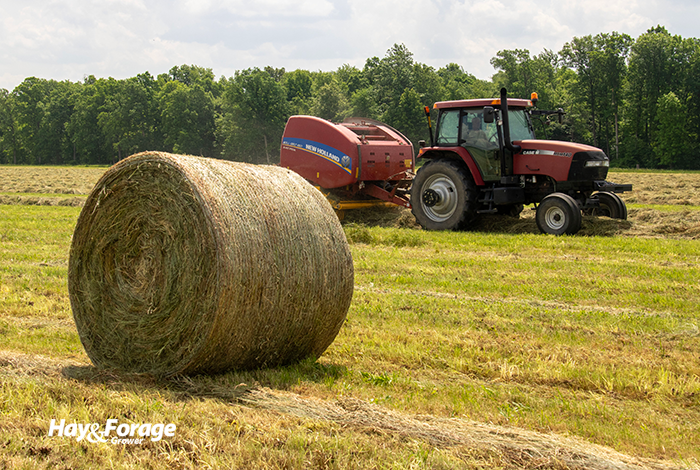
Producers play many roles during the hay season, and meteorologist is often one of them. Despite monitoring forecasts and making plans around rain, one thing farmers from every state can agree on is that the weather is a constant challenge for making hay.
The influence that temperature and precipitation have on total season yields ultimately affect alfalfa and grass hay prices and market dynamics. These factors also impact pasture conditions and the time and rate at which farmers start feeding hay, which indirectly affects market activity as well.
The most prominent news includes persistent drought looming along the eastern edge of the Midwest and in much of the Southeast. States in the center of the country, on the other hand, have encountered excess rain this spring and summer. Both dry and wet conditions threaten to limit hay production and impede hay stocks; however, there are some regions that are experiencing favorable conditions after years of being stuck in a drought.
Dry in the east
The U.S. Drought Monitor currently flashes bright red and orange across the five states of Maryland, Ohio, Pennsylvania, West Virginia, and Virginia. Rainfall there has been up to half of normal levels over the past month, and Ron Hoover with Penn State Extension reports long periods of above average temperatures have compounded this dryness to create the severe and extreme drought.
The coordinator for the university’s on-farm research program says the hot, dry conditions have been especially stressful for the region’s cool-season hay crops like orchardgrass and smooth bromegrass.
“They don’t like it when it’s 90-plus degrees, and couple that with limited water for transpiration, and it makes it even more stressful,” Hoover says in a Lancaster Farming article by staff reporter Tom Venesky. “These grasses are just like our lawns, and they shut down when it gets this hot.”
The drought has slashed second cutting hay yields compared to the relatively good first crop. In fact, parts of Ohio and most of Pennsylvania received average or better rainfall in April and May leading up to first cutting. This bumper crop might help maintain hay prices and bolster hay stocks for winter feeding, but it may not have been enough to offset the yield losses that are expected in the second half of the growing season.
“At the very least, the first cutting helped put hay in the barn for winter,” Hoover adds. “It might be lower quality, but it’s better than snowballs.”
Maryland’s Donald Gott can confirm the pessimistic predictions for second cutting yields of alfalfa and orchardgrass due to the 100-degree temperatures and minimal precipitation on his farm in the southern part of the Old Line State.
In the same Lancaster Farming article, Gott notes a fourth cutting of grass hay likely isn’t in the cards this year considering the drought stress his stands have already endured. He plans on topdressing grass stands with nitrogen and hoping for rain to salvage what he can from a third harvest.
“We can go into October if everything lines up with the weather, but the heat this year definitely set everything back, and if it keeps up, hay is going to be short this winter,” Gott says.
A wet Midwest
Mother Nature is writing a different story in parts of the Midwest where excessive rainfall during the first part of the growing season set back harvest schedules and caused major flood damage in fields. Even when soil dried up and skies cleared long enough to get hay cut, subsequent showers and storms brought unexpected rain onto windrows and left farmers with a lower quality product than they anticipated.
Similarly, eastern Kansas and parts of Nebraska and South Dakota have received more rain than normal this summer. In an article from Kansas State University, Phillip Lancaster notes the wet weather has specifically caused implications in grazing systems where forage soaking up extra rain has grown more rapidly and matured too quickly.
“We think rain is always good — and do not get me wrong, rain is good for grass and cattle — but ultimately, too much rain is bad,” the beef cattle nutritionist states. “The Goldilocks effect applies to this situation, too; we need the right amount to thrive.”
Lancaster recommends supplementing cows on pasture to ensure they receive adequate nutrition despite the flush of fast-growing grass; however, he expects these animals to wean calves off at a lower body condition score and possibly have a harder time getting rebred. Soggy pastures present other challenges to beef production, including more cases of foot rot and greater risk of stand damage.
“When soft ground gets a lot of hoof traffic, the grass will die quicker in that area. Then, we are going to have more weeds come in, and pretty soon, there are large areas of a pasture that are nonproductive,” Lancaster asserts.
Some relief in Texas
On the other hand, higher rainfall has been a welcome predicament in south central Texas. The past two years have been exceptionally dry for farmers in this part of the Lone Star State who have trimmed their five-cut harvest schedules down to two or three. With some additional moisture, though, many are feeling more optimistic about total grass hay yields this year.
David Anderson, a professor and extension economist with the Texas A&M AgriLife Extension Service, predicts a surge in hay supplies will pull future hay prices lower. This comes after a period of tough growing conditions and high hay prices that have prompted some livestock producers to reduce their herd size. With that being said, the region’s long-term forecast shows hotter and drier weather patterns to settle in again, so time will tell how impactful the bouts of late July rainfall will be.

